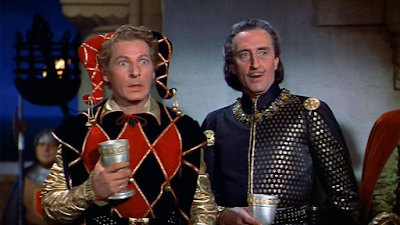Quanto de ação pode ser contida em alguns minutes de projeção de um filme? Se você é fã de filmes mudos, você sabe que a resposta para esta pergunta é MUITA AÇÃO. Há milhares de exemplos de filmes de um ou dois rolos cheios de ação feitos na era muda. Mas hoje vamos além deles e analisamos um filme de cinco rolos cheio de ação feito por Max Linder - seu mais conhecido trabalho filmado em Hollywood.
How much action can you pack in a few minutes of film? If you are a silent movie fan, you know the answer is A LOT. There are thousands of examples of action-packed one-reelers and two-reelers in silent cinema. But today we go beyond and analyze an action-packed five reeler by Max Linder - his best known effort in Hollywood.
Dart-In-Again (Max Linder) recebe uma espada de seu pai e sai para conquistar o mundo. Seu destino é Paris, onde reina o Rei Luís XIII (Frank Cooke). Há diversas intrigas em andamento na corte: a Rainha Anne (Caroline Rankin) tem um amante, enquanto o conselheiro do rei, Cardeal Richie-Loo (Bull Montana), está conspirando contra o monarca.
Dart-In-Again (Max Linder) receives a spear from his father and leaves to conquer the world. His destination is Paris, where King Louis XIII (Frank Cooke) reigns. There are several intrigues going on at the court: Queen Anne (Caroline Rankin) has a lover, while the King’s counselor Cardinal Richie-Loo (Bull Montana) is conspiring against the King.
Dart-In-Again demonstra sua bravura e seus movimentos com a espada e é aceito como um dos Mosqueteiros do Rei. Ele recebe como sua primeira missão uma viagem para a Inglaterra para recuperar as jóias semipreciosas da Rainha que estão com o amante dela. Mas o Cardeal Richie-Loo tentará impedir que Dart-In-Again cumpra sua missão.
Dart-in-Again showcases his bravery and his moves with the sword and is accepted as the fourth of the King’s Musketeers. He receives as his first mission a trip to England to recover the Queen’s semi-precious jewels that are currently with her lover. But the Cardinal Richie-Loo will try to stop Dart-In-Again from accomplishing the recovery.
É óbvio que “O Mosqueteiro” é uma paródia de “Os Três Mosqueteiros” de Douglas Fairbanks, que estreou em agosto de 1921. O filme de Max Linder estreou um ano depois, em setembro de 1922 e, apesar de não ser tão atlético quanto Fairbanks, Linder consegue exibir suas habilidades como acrobata. Ele interpreta Dart-In-Again não como um bobo para alívio cômico: na verdade, o personagem se mostra mais esperto que o cardeal e seus capangas.
It’s obvious that “The Three Must-Get-Theres” is a spoof of Douglas Fairbanks’ “The Three Musketeers”, that premiered in August 1921. Max Linder’s film premiered one year later, in September of 1922, and, although not as athletic as Fairbanks, Linder manages to show off his skills as an acrobat. He plays Dart-In-Again not like a fool for comic purposes: in fact, Dart outsmarts the Cardinal and many of his foes.
O que é sim usado como alívio cômico são os anacronismos: podemos ver durante o filme diversos equipamentos - que não haviam ainda sido inventados na época do Rei Luís XIII - sendo usados pelos personagens, como o telefone em várias cenas, a máquina de escrever e a motocicleta.
What is actually used for comic purposes is anachronism: we can see throughout the movie several gadgets - that were not yet invented by the time of Louis XIII - being used by the characters, like the telephone in several moments, the typing machine and the motorcycle.
Como Connie Bonne-aux-Fieux, a criada particular da Rainha e sua confidente, temos uma atriz que foi popular na era muda, mas está quase esquecida atualmente: Jobyna Ralston. Este é um de seus primeiros filmes e ela encontraria a fama como protagonista dos filmes de Harold Lloyd a partir de 1923. Um de seus mais famosos papéis é o de Sylvia Lewis em “Asas” (1927). Depois de três filmes falados, ela abandonou o cinema, pois estava casada com seu colega de elenco de “Asas”, Richard Arlen.
As Connie Bonne-aux-Fieux, the Queen’s chambermaid and confidant, we have an actress popular in the silent era, but nearly forgotten today: Jobyna Ralston. This is one of her first movies and she would find more fame as Harold Lloyd’s leading lady starting in 1923. One of her best known roles is Sylvia Lewis in “Wings” (1927). After three talkies, she left the movie business, as she was now married to her “Wings” co-star Richard Arlen.
Max Linder foi verdadeiramente a primeira estrela de cinema internacional. Ele começou como coadjuvante para os estúdios Pathé em 1905, e em 1911 já estava escrevendo e co-dirigindo curtas em que interpretava Max, um homem elegante sempre em apuros. Seus curtas eram sucesso por toda parte, mas veio a guerra e Max foi lutar pela França. Ele se envolveu em um sério acidente de carro, e sua vida nunca mais foi a mesma. A depressão crônica surgiu em sua vida naquele momento e jamais abandonou Max, causando problemas para trabalhar e por fim matando Max em um suicídio em 1925.
Max Linder was truly the first international movie star. He started as a supporting player for Pathé shorts in 1905, and by 1911 was already writing and co-directing shorts in which he played Max, a dapper gentleman always in trouble. His shorts found success everywhere, but the war came and Max went to fight for France. He was involved in a serious car crash, and his life was never the same again. Chronic depression appeared at the time in Linder’s life and would never leave him, causing trouble to work and ultimately killing him in a suicide in 1925.
“O Mosqueteiro” é um dos três médias-metragens feitos por Max Linder em Hollywood com sua própria produtora, sendo os outros dois “Sete Anos de Azar” e “Seja Minha Mulher”, ambos de 1921. Linder produziu, escreveu e dirigiu o filme. Ele demonstra perfeito domínio da língua inglesa, fazendo jogos de palavras com os nomes de seu e de outros personagens, além de adicionar diversos trocadilhos às cartelas de texto. Infelizmente, muitos destes trocadilhos se perdem com a tradução: na versão a que eu assisti, o tradutor escolheu eliminar todos os nomes com trocadilhos, usando no lugar os nomes reais dos personagens verídicos e dos mosqueteiros.
“The Three Must-Get-Theres” is one of three featurettes made by Max Linder in Hollywood under his own production company, the two others being “Seven Years Bad Luck” and “Be my Wife”, both from 1921. Linder produced, wrote and directed the film. He shows perfect knowledge of the English language, doing wordplay with his and other characters’ names, as well as adding several puns to the title cards. Unfortunately, many of these puns get lost in translation: in the version I saw, the translator chose to eliminate all punny names, using instead the real names of historical characters and the musketeers.
No começo do filme aparece um aviso de que a versão norte-americana do filme se perdeu, e o que podemos ver hoje é uma restauração feita usando como base a versão no Netherlands Filmmuseum. A restauração e gravação da nova trilha sonora foram feitas em 2008. Não há por que se perguntar qual a causa do desaparecimento da versão norte-americana: o filme não foi um sucesso de bilheteria, o que deixou Linder desapontado e achando que ele não era mais engraçado.
In the beginning of the film, there is a disclaimer that the American version of the film has disappeared, and what we can see today is a restoration made using as basis the version at the Netherlands Filmmuseum. The restoration and recording of the new soundtrack were made in 2008. There is no wonder to why the American version of the film disappeared: it wasn’t a box-office success, which left Linder disappointed and thinking he just wasn’t funny anymore.
Admirado por Charles Chaplin - que se referia a ele como “Professor” em algumas fotos autografadas - Max Linder merece o reconhecimento que vem recebendo agora, mais de um século após experimentar pela primeira vez o estrelato. Se você nunca viu Linder em ação, ou se ainda tem dúvidas sobre por que ele foi a primeira estrela de cinema internacional, não precisa procurar outro filme: “O Mosqueteiro” foi totalmente concebido por ele e é uma amostra perfeita do talento único que Linder tinha para a comédia.
Admired by Charles Chaplin - who called him his
“Professor” in some autographed photos - Max Linder deserves the recognition he
is receiving now, more than a century after he first experienced stardom. If
you have never seen Linder in action, or if you still have doubts about why he
was the first international movie star, look no further: “The Three
Must-Get-Theres” is wholly his brainchild and a perfect showcase of Linder’s unmatched
talent for comedy.





























